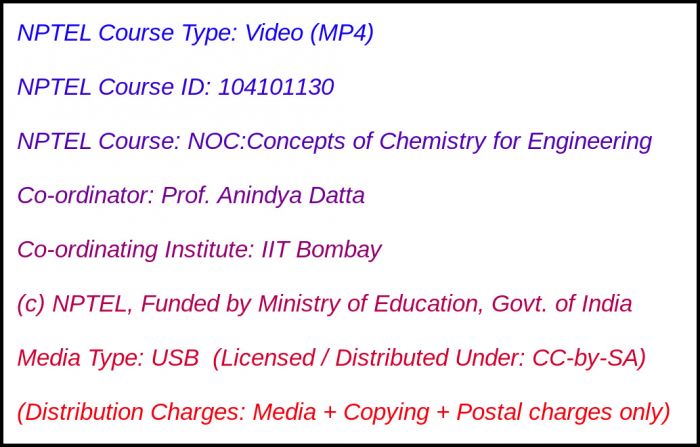
Media Storage Type : 32 GB USB Stick
NPTEL Subject Matter Expert : Prof. Anindya Datta
NPTEL Co-ordinating Institute : IIT Bombay
NPTEL Lecture Count : 77
NPTEL Course Size : 9.2 GB
NPTEL PDF Text Transcription : Available and Included
NPTEL Subtitle Transcription : Available and Included (SRT)
Lecture Titles:
Lecture 1 - Introduction to quantum theory
Lecture 2 - Schrodinger's theory
Lecture 3 - Laws of quantum mechanics
Lecture 4 - Wave functions
Lecture 5 - Quantum mechanics of a free particle
Lecture 6 - Particle in 1D box
Lecture 7 - Particle in 2D box
Lecture 8 - Spherical polar coordinates and angular momentum
Lecture 9 - Developing Hydrogen atom orbitals - 1
Lecture 10 - Developing Hydrogen atom orbitals - 2
Lecture 11 - Developing Hydrogen atom orbitals - 3
Lecture 12 - Visualizing molecular orbitals
Lecture 13 - Molecular orbital theory 1: Introduction
Lecture 14 - Molecular orbital theory 2: Diatomic molecules
Lecture 15 - Molecular orbital theory 3: Homo-diatomic molecules - I
Lecture 16 - Molecular orbital theory 4: Homo-diatomic molecules - II
Lecture 17 - Molecular orbital theory 5: Hetero-diatomic molecules
Lecture 18 - Molecular orbital theory 6: Polyatomic molecules
Lecture 19 - Molecular orbital theory 7: Ethylene (Introduction to Huckel's theory) - I
Lecture 20 - Molecular orbital theory 8: Ethylene (Introduction to Huckel's theory) - II
Lecture 21 - Molecular orbital theory 9: Butadiene - I
Lecture 22 - Molecular orbital theory 9: Butadiene - II
Lecture 23 - Concept of effective nuclear charge
Lecture 24 - Electronic configuration of elements
Lecture 25 - Properties of Elements (Size, IE, EA and EN)
Lecture 26 - Polarizability
Lecture 27 - Hard soft acid base
Lecture 28 - Predicting molecular structures: VSEPR theory
Lecture 29 - Coordination Chemistry: 18 electron rule and VBT
Lecture 30 - Crystal Field Theory: Octahedral Complex
Lecture 31 - Crystal Field Theory: Tetrahedral Complex
Lecture 32 - Crystal Field Theory: Octahedral vs. Tetrahedral Complex
Lecture 33 - Application of CFSE: Spinel and J-T Distortion
Lecture 34 - Introduction to Molecular Magnetism
Lecture 35 - Problem Solving Approach
Lecture 36 - Magnetism
Lecture 37 - Spectroscopic Term Symbol
Lecture 38 - Magnetic States of Matter: Paramagnetic, Ferro and Antiferromagnetic
Lecture 39 - Band structures of solid materials
Lecture 40 - Density of states and doping in semiconductors
Lecture 41 - Introduction to molecular spectroscopy
Lecture 42 - Rotational spectroscopy
Lecture 43 - Vibrational spectroscopy
Lecture 44 - Electronic Spectroscopy - I
Lecture 45 - Electronic Spectroscopy - II
Lecture 46 - Electronic Spectroscopy - III
Lecture 47 - Fluorescence Spectroscopy
Lecture 48 - Fundamentals of NMR spectroscopy and MRI
Lecture 49 - Surface characterization techniques
Lecture 50 - Introduction to thermodynamics: Work, heat and energy
Lecture 51 - First law of thermodynamics: Diathermic and adiabatic systems,exothermic and endothermic processes
Lecture 52 - Enthalpy, Hess's law
Lecture 53 - Second law of thermodynamics: Entropy and third law of thermodynamics
Lecture 54 - Helmholtz and Gibbs free energies, Concept of spontaneity
Lecture 55 - Electrochemical equilibrium, Nernst equation
Lecture 56 - Acid base and solubility equilibria
Lecture 57 - Corrosion
Lecture 58 - Extraction of metals
Lecture 59 - Ellingham Diagram
Lecture 60 - Problems From Thermodynamics
Lecture 61 - Intermolecular forces: Electrostatic and Ion-Dipole Interaction
Lecture 62 - Intermolecular forces: Dipole-dipole, hydrogen bonding
Lecture 63 - Real gases - Part 1
Lecture 64 - Real gases - Part 2
Lecture 65 - Introduction to Potential Energy Surfaces
Lecture 66 - Potential energy surface of H3 system
Lecture 67 - Salient features of H3 potential energy surface
Lecture 68 - Potential Energy Surfaces of HCN and H2F system
Lecture 69 - Representation of three dimensional structures
Lecture 70 - Structural isomers and stereoisomers
Lecture 71 - Configurations, Symmetry and Chirality
Lecture 72 - Enantiomers and Diastereomers
Lecture 73 - Optical activity, Conformational analysis, and absolute configuration
Lecture 74 - Substitution reactions
Lecture 75 - Elimination reactions
Lecture 76 - Addition, Oxidation and Reduction reactions
Lecture 77 - Synthesis of a drug molecule

